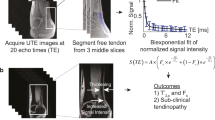Abstract
To determine whether the echo time of magnetic resonance gradient-echo and spin-echo imaging sequences may be important for the occurrence of high signal strength from tendon with pathological alterations, imaging sequences with sufficient spatial resolution and very short echo times were developed for whole-body imagers with standard gradient system. The sequences were applied on the Achilles tendons of five healthy volunteers and seven patients with achillodynia. Some affected regions inside tendon, probably corresponding with tissue with subtle edema in the collagen bundles were only revealed in images recorded with very short echo times TE<5 ms, whereas stronger affections and protons in liquids between the fiber bundles were also shown in images with longer echo times TE>10 ms. Gradient-echo methods allow shorter echo times than spin-echo techniques for a given gradient system of the imager and given spatial resolution. So minimum echo time gradient-echo sequences should be used for sensitive imaging of tendon alterations, because no considerable signal dephasing due to susceptibility effects were found in tendon.
Similar content being viewed by others
References
Quinn SF, Murray WT, Clark RA, Cochran CF (1987) Achilles tendon: MR imaging at 1.5 T.Radiology 164 767.
Marcus DS, Reicher MA, Kellerhouse LE (1989) Achilles tendon injuries: the role of MR imaging.J Comput Assist Tomogr 13 480.
Neuhold A, Stiskal M, Kainberger F, Schwaighofer B (1992) Degenerative Achilles tendon disease: assessment by magnetic resonance and ultrasonography.Eur J Radiol 14 213.
Schweitzer ME (1993) Magnetic resonance imaging of foot and angle.Magn Reson Quart 9 214.
Fullerton GD, Cameron IL, Ord VA (1985) Orientation of tendons in the magnetic field and its effect on T2 relaxation times.Radiology 155 433.
Erickson SJ, Cox IH, Hyde JS, Carrera GF, Strandt JA, Estkowski LD (1991) Effect of tendon orientation on MR imaging signal intensity: a manifestation of the “magic angle” phenomenon.Radiology 181 389.
Erickson SJ, Prost RW, Timins ME (1993) The “magic angle” effect: background physics and clinical relevance.Radiology 188 23.
Koblik PD, Freeman DM (1993) Short echo time magnetic resonance imaging of tendon.Invest Radiol 28 1095.
Haase A, Frahm J, Matthaei D, Hänicke W, Merboldt KD (1986) FLASH imaging. Rapid NMR imaging using low flip-angle pulses.J Magn Reson 67 258.
Author information
Authors and Affiliations
Rights and permissions
About this article
Cite this article
Schick, F., Dammann, F., Lutz, O. et al. Adapted techniques for clinical MR imaging of tendons. MAGMA 3, 103–107 (1995). https://doi.org/10.1007/BF01709854
Received:
Issue Date:
DOI: https://doi.org/10.1007/BF01709854




